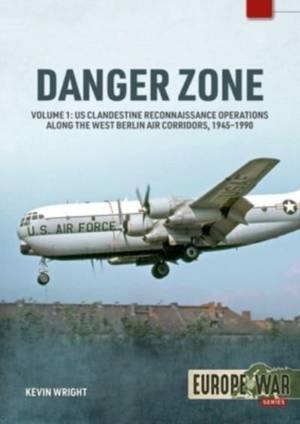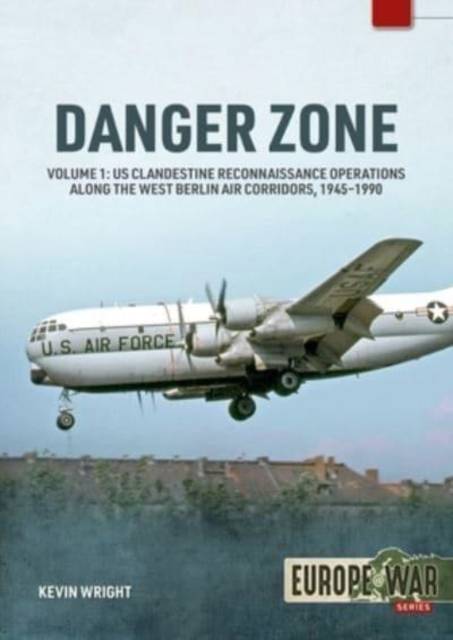
- Retrait gratuit dans votre magasin Club
- 7.000.000 titres dans notre catalogue
- Payer en toute sécurité
- Toujours un magasin près de chez vous
- Retrait gratuit dans votre magasin Club
- 7.000.0000 titres dans notre catalogue
- Payer en toute sécurité
- Toujours un magasin près de chez vous
Danger Zone
Us Clandestine Reconnaissance Operations Along the West Berlin Air Corridors, 1945-1990
Kevin Wright
27,95 €
+ 55 points
Description
"...you'll find just about everything you would want to know about operations above one of the hottest spots of the Cold War. It is an interesting look at a major information collection operation that was mostly hidden in plain sight." -- Aviation History Magazine
Divided in two for decades between the late 1940s and early 1990s, Germany was the hottest 'battlefield' of the Cold War. Its western part was dotted by dozens of major military facilities of the reconstituted national armed forces and those of the NATO allies, foremost the USA, Great Britain and France. Even more so, one third of East Germany was under the control of the Armed Forces of the Union of Soviet Socialist Republics (USSR) and housed several dozens of major air and ground units.
On the ground, the city of West Berlin - situated in the center of the German Democratic Republic (GDR) - and the three occupation zones controlled by the USA, Great Britain, and France, was connected to the outside world only via tightly controlled railways, waterways or autobahns. However, in the air, three Aerial Corridors connected it with West Germany.
Far away from high-profile intelligence-gathering operations - like those by Lockheed U-2s - several intelligence agencies of the USA, Great Britain and France exploited this fact to run covert operations along these Corridors.
Principally conducted by adapted transport or liaison aircraft - which received a host of clandestine modifications - such operations often took their crews into the very center of what was perceived as the 'danger zone' by NATO: the airspace over some of the most sensitive Soviet military installations.
Danger Zone is the first comprehensive and in-depth study of intelligence-gathering efforts by aircraft operated by, or on behalf of, the US intelligence agencies. It provides a carefully researched review of the involved equipment, modifications, maintenance, flight operations, post-flight activities and the resulting intelligence analysis, set within the context of the unique situation surrounding West Berlin during the Cold War and its Air Corridors.
Divided in two for decades between the late 1940s and early 1990s, Germany was the hottest 'battlefield' of the Cold War. Its western part was dotted by dozens of major military facilities of the reconstituted national armed forces and those of the NATO allies, foremost the USA, Great Britain and France. Even more so, one third of East Germany was under the control of the Armed Forces of the Union of Soviet Socialist Republics (USSR) and housed several dozens of major air and ground units.
On the ground, the city of West Berlin - situated in the center of the German Democratic Republic (GDR) - and the three occupation zones controlled by the USA, Great Britain, and France, was connected to the outside world only via tightly controlled railways, waterways or autobahns. However, in the air, three Aerial Corridors connected it with West Germany.
Far away from high-profile intelligence-gathering operations - like those by Lockheed U-2s - several intelligence agencies of the USA, Great Britain and France exploited this fact to run covert operations along these Corridors.
Principally conducted by adapted transport or liaison aircraft - which received a host of clandestine modifications - such operations often took their crews into the very center of what was perceived as the 'danger zone' by NATO: the airspace over some of the most sensitive Soviet military installations.
Danger Zone is the first comprehensive and in-depth study of intelligence-gathering efforts by aircraft operated by, or on behalf of, the US intelligence agencies. It provides a carefully researched review of the involved equipment, modifications, maintenance, flight operations, post-flight activities and the resulting intelligence analysis, set within the context of the unique situation surrounding West Berlin during the Cold War and its Air Corridors.
Spécifications
Parties prenantes
- Auteur(s) :
- Editeur:
Contenu
- Nombre de pages :
- 88
- Langue:
- Anglais
- Collection :
Caractéristiques
- EAN:
- 9781804510254
- Date de parution :
- 18-04-23
- Format:
- Livre broché
- Format numérique:
- Trade paperback (VS)
- Dimensions :
- 218 mm x 290 mm
- Poids :
- 317 g

Les avis
Nous publions uniquement les avis qui respectent les conditions requises. Consultez nos conditions pour les avis.






